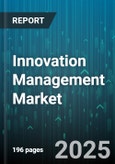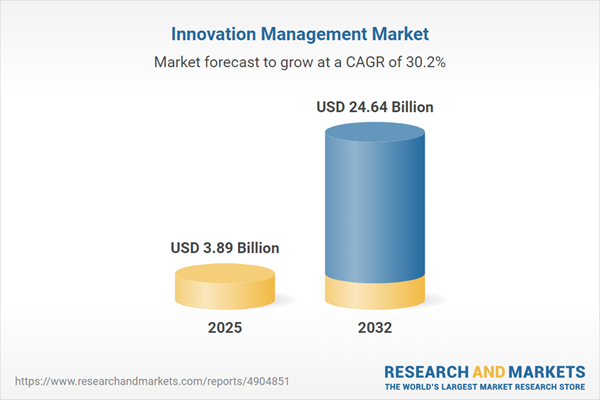Speak directly to the analyst to clarify any post sales queries you may have.
The innovation management software market is undergoing rapid transformation as organizations shift toward digital strategies that foster continuous improvement, compliance, and operational efficiency. Senior executives increasingly rely on these platforms to synchronize enterprise innovation efforts and maintain competitiveness in dynamic environments.
Market Snapshot: Growth and Strategic Direction of the Innovation Management Software Market
The innovation management software market shows robust expansion year-over-year, driven by demand for integrated digital solutions that enable idea capture, project management, and real-time analytics under a unified interface. Companies are adopting cloud-native platforms for their scalability and adaptability, building resilient digital infrastructure that supports both strategic and operational initiatives. Software providers are continuously releasing new features to help enterprises navigate regulatory complexity, stay agile, and align innovation strategies with shifting business objectives. As technological modernization accelerates transformation efforts, leadership teams use these platforms to orchestrate strategic change and uphold effective governance across increasingly global and regulated landscapes.
Scope & Segmentation: Comprehensive Innovation Management Software Solutions
- Component: Consulting services, open innovation tools, customizable workflows, integration features, advanced analytics, idea moderation, project tracking, training programs, collaboration tools, portfolio management, and trend monitoring equip organizations to design and execute tailored innovation programs.
- Pricing Model: Enterprise agreements, feature-based subscriptions, perpetual licenses, user quota frameworks, usage-based rates, and API access options provide flexibility and address diverse procurement needs.
- Organization Size: Solutions are configured for small businesses, mid-sized firms, and multinational corporations, enabling scalable rollouts from targeted units to fully integrated enterprise deployments.
- Deployment Mode: Public, private, and hybrid cloud options, along with on-premises deployment, allow organizations to meet specific compliance, security, and data governance requirements across jurisdictions.
- Application: Popular use cases include co-creation programs, hackathons, innovation workshops, crowdsourcing campaigns, partnerships, knowledge stewardship, patent tracking, lifecycle management, R&D control, scenario planning, and startup engagement, supporting unique needs throughout the innovation lifecycle.
- End-Use Industry: Aerospace, defense, automotive, finance, chemicals, education, energy, government, healthcare, IT and telecom, logistics, manufacturing, media, retail, consumer goods, transportation, and hospitality rely on these solutions to solve industry-specific compliance, data, and operational challenges.
- Region: Key adoption regions include the Americas, Europe, Middle East and Africa, and Asia-Pacific. In Asia-Pacific, digital transformation in China, India, Japan, Australia, and Southeast Asia is increasing the demand for advanced innovation management.
- Key Companies: Major vendors such as Planview, Brightidea, HYPE Innovation, Qmarkets, IdeaScale, Wazoku, Imaginatik, Exago Software, Ideanote, and SAP SE update features and services in response to compliance and operational needs across different markets.
Key Takeaways for Senior Decision-Makers
- Innovation management software unites strategic direction with project execution, enhancing executive oversight and enabling objective assessment throughout the innovation process.
- Flexible deployment models support compliance and data governance, helping organizations adapt to evolving regulatory conditions while minimizing risk exposure.
- Advanced analytics and artificial intelligence embedded in these platforms detect emerging opportunities, optimize innovation pipelines, and provide timely insights for strategic decision-making.
- Cloud-based, modular architecture ensures that organizations can efficiently scale as they expand geographically or react to business changes without overextending their technology budgets.
- Industry-targeted compliance features are essential in sectors prioritizing data security and intellectual property protection, supporting safe innovation within and across global markets.
- Integration-ready ecosystems accelerate deployment, streamline alignment with current IT infrastructure, and enable ongoing process optimization for continuous improvement.
Tariff Impact and Market Adaptation
Recent changes to U.S. tariffs are prompting enterprises to accelerate adoption of cloud-based innovation management platforms. This shift enables more predictable budgeting and lowers initial capital requirements. As regulatory compliance and workplace policies tighten, solution providers adjust both pricing structures and platform capabilities to support international clients and ensure ongoing regulatory alignment.
Methodology & Data Sources
This market research synthesizes executive interviews, insight from IT and product decision-makers, continuous regulatory trend monitoring, and analysis of organizational case studies. The blended approach grounds findings in both technology evolution and the operational realities faced by businesses deploying innovation management software.
Why This Report Matters for Executives in Innovation Management
- Guides selection of adaptive, resilient platforms that can accommodate ongoing regulatory, organizational, and technological change in innovation management strategies.
- Delivers practical insights for effectively managing compliance and risk during periods of industry disruption or new policy introduction.
- Helps executives align investment strategies with innovation goals to ensure digital transformation delivers clear business value.
Conclusion
Innovation management software provides a framework for leading transformation, maintaining regulatory compliance, and reinforcing a culture of innovation. These platforms position organizations for resilience and sustained growth in evolving global markets.
Additional Product Information:
- Purchase of this report includes 1 year online access with quarterly updates.
- This report can be updated on request. Please contact our Customer Experience team using the Ask a Question widget on our website.
Table of Contents
3. Executive Summary
4. Market Overview
7. Cumulative Impact of Artificial Intelligence 2025
Companies Mentioned
The companies profiled in this Innovation Management market report include:- Planview, Inc.
- Brightidea, Inc.
- HYPE Innovation GmbH
- Qmarkets Ltd.
- IdeaScale, Inc.
- Wazoku Ltd.
- Imaginatik, Inc.
- Exago Software, Lda.
- Ideanote ApS
- SAP SE
Table Information
| Report Attribute | Details |
|---|---|
| No. of Pages | 196 |
| Published | October 2025 |
| Forecast Period | 2025 - 2032 |
| Estimated Market Value ( USD | $ 3.89 Billion |
| Forecasted Market Value ( USD | $ 24.64 Billion |
| Compound Annual Growth Rate | 30.1% |
| Regions Covered | Global |
| No. of Companies Mentioned | 11 |









